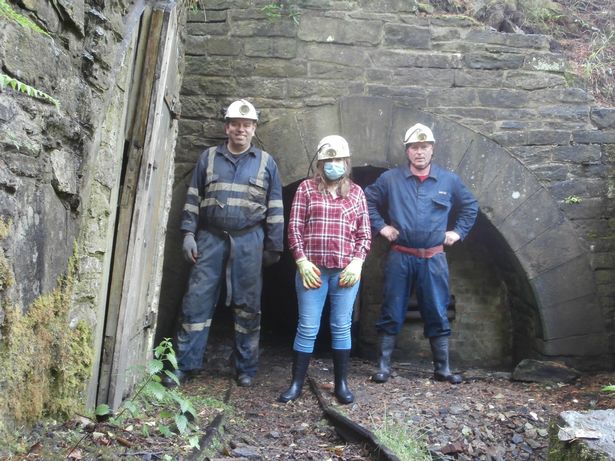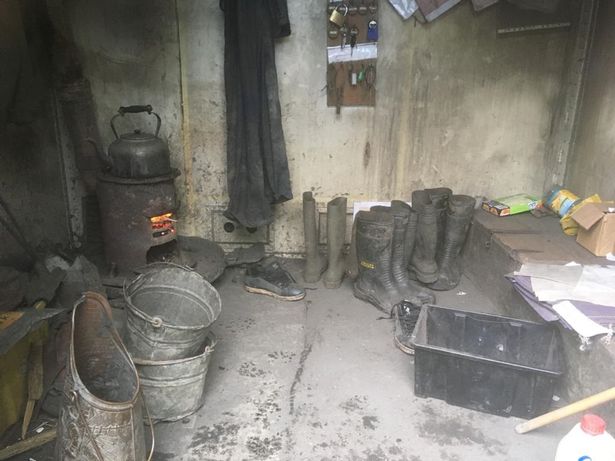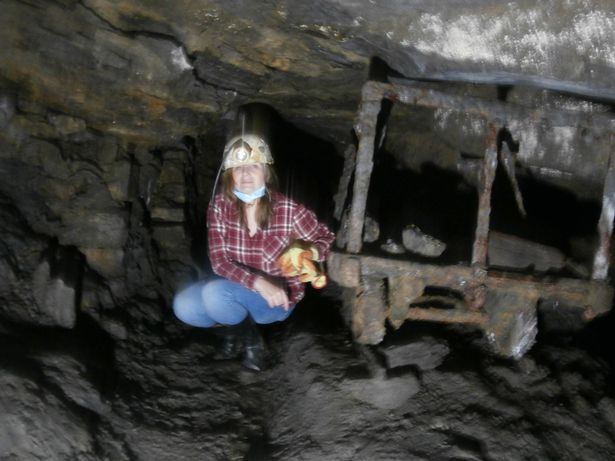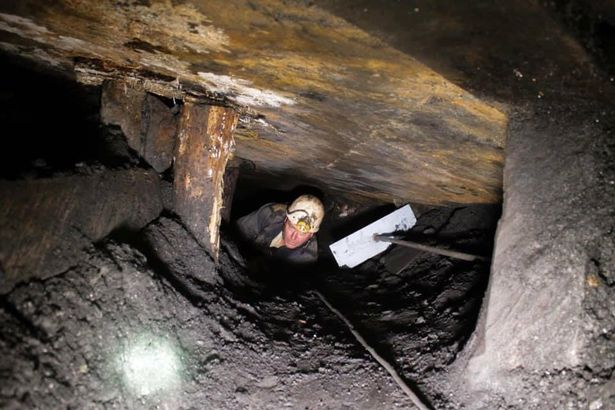England: The Secret World of the Forest of Dean Freeminers

July 5, 2020 - Ask any of the men who go freemining in England's Forest of Dean why they do it and they smile wryly and say: “It’s different world underground, mind”.
The phrase was coined by part-time miner Paul Baverstock to answer the question: “Why on earth do you choose to spend your leisure time mining coal by hand?”
Wouldn’t you prefer to watch TV, go cycling in the woods or nip down the road to watch the rugby at Cinderford?
Paul says the only way to understand is to try it so I jump at the chance to go down Morse’s Level, a small mine in a secluded patch of Forest that has been producing coal since George Morse asserted his birthright nearly 200 years ago.
We actually meet at the nearby Wallsend Colliery which at first sight looks like a scene from an old black and white movie with tin buckets and bowls and corrugated iron everywhere.
Inside a former army bomb shelter, a large, steaming kettle sits on a stove that burns with a warm glow under a long row of mugs hanging on hooks. There’s also long rows of dirty overalls and a long row of wellies and I immediately realise why they do it.
Even before the first man man utters the word “camaraderie” it’s clear that this is the ultimate man shed. A place where men of all ages can get together for a chinwag about metal and machines.
“It’s not deliberate”, says former Xerox worker Rob Rutsch who points out that there is one female freeminer, Elaine Wright from Clearwell Caves. They have had several females give it a go but they seem reluctant to do it on a regular basis.
It’s tempting to say it’s because they are too busy but it’s not just women who don’t want to devote their spare time to a hobby that was once considered dirty, dangerous manual work. Like many others Rob failed to convince his sons that following their father underground was more fun than football.
“My two boys are 23 and 27 and they are not interested,” said the recently retired 62-year-old.
“I used to bring them now and again but the oldest was more into his football and the youngest wants to carry on with his education.”
Fourteen-year-old Keallan is the exception and he and his father Mark have their own small mine, Foresters Folly, to which they escape every Saturday to protect their legacy for future generations.
Morse’s Level is one of a handful of small mines still working and it is owned by three of the Forest’s oldest freeminers – Mike Howells, Paul Schwartz and Rob Rutsch. Most of the younger men working with them every Saturday morning and Tuesday night will never qualify for the official title even thought they have notched up the necessary 'year and a day' underground.
Being born within the Hundred of St Briavels is key to claiming the birthright and local maternity hospital closed in the 1980’s.
At one time there were around 200 men and boys making a living in this tiny enclave and in 1880 it produced 8,837 tonnes of coal. Last year they dug out 40 tonnes of coal by hand.
Aged from 14 to 71, they come from different places and backgrounds and there’s non-stop banter between them as they crank up the machine which grades the coal before it is bagged.
As far as I can make out, today’s main task is an exciting one. They are planning to drop a massive, metal cylinder into a huge hole to create an air shaft which allows them to bypass a rockfall. It all sounds very Fred Dibnah.
Just a few hundred yards away from where we duck into the dressed stone arch which forms the hidden mine entrance, people are already gathering at Mallard’s Pike unaware of the picks and shovels being wielded under the nearby woodlands.
Maybe it’s the peacefulness, maybe it’s the beauty of the rocks or maybe it’s because it is one of the few places in the world where it’s better to be 5’2” than 6’2”, but I don’t feel scared as I follow Paul Baverstock and Iain Jamieson down the damp, ever shrinking tunnel.
“The hats are not to protect you, they are to remind you to duck,” laughs Iain as I bump my head for the umpteenth time .
The air is cool and fresh but not cold or damp as they point out fossilised trees and layers of coal in the smooth rock slabs which form the roof and walls of the mine itself.
But it’s the history that makes it so fascinating as we disappear into the darkness with only the ghosts of the old miners to keep us company.
When Iain turns out the lights we are engulfed in a deep, velvety blackness which brings home the mental bravery it took to dig out this network of tunnels where miners would spend 12 to 14 hours a day hacking at the coal face.
An old cart from the 1800s is lovingly left in situ is a reminder of those who went before. An innocuous pile of stones turns out to be an historically important ventilation system. They try to leave it as they find it.
The most evocative legacy is an old hodding road. Once children as young as six would crawl through tiny U-shaped tunnels pulling a wooden sledge behind them so they could transport the black stuff between the coal face and the carts.
Their fathers would fill the sledge with coal and their mothers would rub their knees with urine to toughen up the skin. Seeing the actual tunnels where children would work by candlelight for 12 hours at a time really brought it home how lonely and frightening it must have been for the young hodders.
It’s clear Paul and Iain know these tunnels like a Forest taxi driver knows the streets Cinderford and they are keen reassure me that they are both trained and experienced mine and cave rescuers.
It won't happen, they say about roof collapses.. Why then do they still have “telltales”, wooden sticks inserted into the cracks, so they can see if the rocks have moved?
Seriously though, what miners do fear are rapidly rising water levels flooding the mines and pockets of the dreaded black damp. If the candles go out you have move quick before a mixture of odourless gases literally sucks the life out of you.
‘Don’t worry, it’s painless’, they say so jovially that when they point out small hole on the main path and claim I will be climbing into it later on, I think it’s the kind of wind up that goes with the job.
But no, it turns out that the coal face is not a Lord of the Rings style towering black wall at the end of a tunnel as I had imagined. Just when I think I am on the way out they tell me it’s time to disappear down the pothole they pointed out earlier.
Despite my protestations about putting on a few pounds during lockdown, Paul leaves me with no choice but to follow him and squeeze through the cold hard rock until it opens out into a mini cavern where I drag myself through the wet, claggy clay on my belly until I come to a halt at a wall of rock in a cramped area with tiny pit props.
It is so low I can hardly sit up in he black dust but as I try and steady myself by putting a knee against the wooden pole, Paul passes me a heavy, metal pick and tells me to start mining. “Here?” I ask incredulously. “Yes. Here,” he answers.
I manage 20 seconds of what he described as ‘tickling’ the rock and send a few tiny splinters of coal flying through the air before I put the pick down.
Even so, as I eventually manage to wriggle and writhe back out the hole with the seat of my jeans caked in mud, I’m pleased with myself and it’s almost disappointing when the sunlight comes into a view after a long trudge back to the entrance.
What have I learned? Firstly, in the old days my family would have starved. Secondly, I was too soft on the kids. Thirdly, it really is a different world underground.
What's more I rather like it and understand the attraction.
Just don't ask me to give up my Saturday lie-ins to do it.

Iain Jamieson, Janet Hughes and Paul Baverstock

Inside the shed after the miners have left

Gloucestershire Live's Janet Hughes next to an original cart underground at Morse's Level


